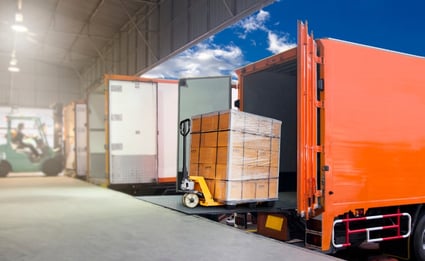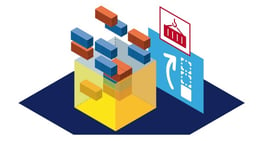The Impact of Logistics 4.0 on Inventory Management
Brian Hoey - May 16, 2019

The rise of Industry 4.0 has saddled supply chain managers with a lot of lofty expectations. With the idea of the so-called global factory, we’re given visions of a future supply chain in which manufacturing processes are so decentralized that the boundaries of any individual production facility become meaningless. By the same token, as we look towards the future of connected digital logistics, we tend to envision a world in which demand-capacity planning is so sophisticated and transport logistics are so agile that the need for physical warehouses of products will dwindle away and ultimately vanish.
This idea might seem farfetched—and it’s certainly true that we’re nowhere near achieving this is the current supply chain—but when you consider the strides that we’re already making in the Logistics 4.0 era it’s certainly not unthinkable. As digital order tracking and routing capabilities improve, logistics providers are increasingly able to reduce lead times by way of smarter bundling of products and more sophisticated demand predictions. While no one will ever be able to predict demand in advance with 100% accuracy, the closer we get the more feasible it will be to operate with various types of goods in constant transit, moving seamlessly from production lines to carriers to last mile operators to their final destinations. In this way, Logistics 4.0 will radically change the nature of inventory management.
Inventory 4.0
Like we said, we’re not especially close to the warehouse-less world that we described above, but that doesn’t mean that Logistics 4.0 isn’t having an impact on inventory management. In some ways, its impact is complementary to the impact that Industry 4.0 is already having. In the modern smart factory, IoT (internet of things) devices and other sensors track the flow of goods into and out of a given warehouse, monitor the conditions of those goods over time, and send automated reports and other data streams back to a centralized planning interface. In this way, planners are able to maintain a real-time digital version of their inventory in order to gain visibility, flexibility, and data-driven insights. In Logistics 4.0 workflows, the same elements are in place, but with a focus on the eventual transport of completed goods, rather than storage of products fresh off the assembly line.
This means that instead of using inventory levels as a way to track demand and the outbound flow of goods in order to inform future production processes (for instance, noticing that you have an overabundance of a particular item in your inventory and pivoting your production processes away form that item until relative quantities stabilize), logistics planners would be doing the reverse: managing demand as it emerges based on the existing volumes and locations of various stock. From a practical perspective, this might put a logistics planner in position to reverse engineer the contents of an incoming order with the aim of finding the most efficient possible way to bundle products and generate routes.
Transport Planning Integration
Okay, we moved pretty quickly through our example of what Logistics 4.0-enabled inventory management might look like in the last section. Let’s slow down for a second a sketch out a more thorough example of how Logistics 4.0 could impact inventory management. For starters, let’s picture a series of different customer orders all coming in around the same time for a medium-sized manufacturer of auto parts. The company has a number of warehouses spread around the country, each one connected via smart sensors to a digital planning platform. When the orders come in, logistics planners search their database to see which warehouses have which relevant products and in what quantities. Because the customers themselves are also spread out geographically, the optimal way to get the right goods to the right place at the right time is far from obvious.
This is where advanced analytics or even machine learning might come in. While a human planner using pen and ink might find it difficult to uncover the set of routes that requires the fewest trucks/person-hours/tanks of gas, a digital analysis of the real-time representation of your transport network would enable you to instantaneously test out alternatives to arrive at the one that meets your customers’ needs in the most cost-effective way. This might (and in fact probably will) involve cutting against the grain of conventional transport wisdom by neither bundling all of one particular product together or making exactly one shipment to each end-destination. In all likelihood, the optimal way to carry out the shipments will involve a complex grouping of different resources from different geographic locations—too complex, probably, to be arrived at without a digital, analytics-empowered workflow.
The Global Warehouse
As processes like the one described above become more common, supply chain managers will likely want to reexamine the way that their inventory strategies are conceived and carried out. For instance, increasingly complex and decentralized transport strategies might push planners towards more decentralized distributions of goods. Because supply chain managers will have the tools necessary to capitalize on newfound sources of data and flexibility, they’ll be in a position to reimagine their workflows around the use of those tools—all in pursuit of a more sophisticated interplay between warehousing and logistics.
Thus, even though the global supply chain is many years away from having no warehouses at all, Logistics 4.0 is rapidly empowering the creation something like a global warehouse—with the principles of Industry 4.0’s global factory recreated in the field of inventory management. As Logistics 4.0 processes gain more widespread adoption within the global value chain, they’ll increasingly empower a connected, decentralized approach to storing goods in anticipation of transport. The geographic boundaries between different storage facilities will become less of an obstacle than ever, potentially leading to an uptick in companies sharing storage space in modern, digitized facilities (with the end-result of something like a cloud-storage model for physical resources). In order to take advantage of this global shift in the way goods are stored and moved, supply chain managers will have to push for greater visibility and digitization within their own companies. In this way, they can be sure of connecting to the global value chain in a way that adds new levels of flexibility and responsiveness to their own operations.
If you want to learn more get your Guide to Industry 4.0:
LATEST POSTS
- Understand Circular Economy in The Manufacturing Industry
- How Can Industry 4.0 IT Integration Be Achieved Smoothly?
- The Significance of Order Sequencing in Discrete Manufacturing
- How to improve your Supply Chain Management: The Power of Control Towers
- Optimizing Human Resource Scheduling in Manufacturing: A Technological Approach



